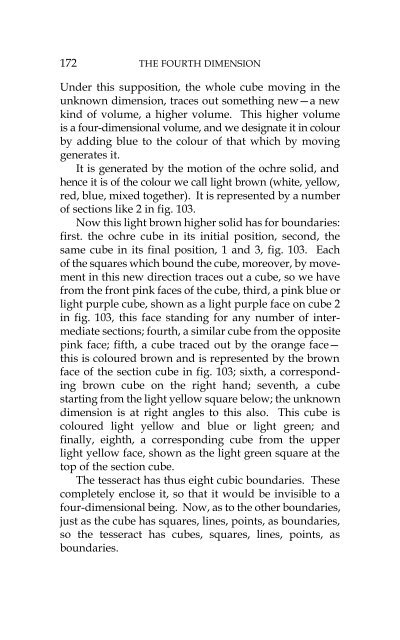Create successful ePaper yourself
Turn your PDF publications into a flip-book with our unique Google optimized e-Paper software.
172<br />
THE FOURTH DIMENSION<br />
Under this supposition, the whole cube moving in the<br />
unknown dimension, traces out something new—a new<br />
kind of volume, a higher volume. This higher volume<br />
is a four-dimensional volume, and we designate it in colour<br />
by adding blue to the colour of that which by moving<br />
generates it.<br />
It is generated by the motion of the ochre solid, and<br />
hence it is of the colour we call light brown (white, yellow,<br />
red, blue, mixed together). It is represented by a number<br />
of sections like 2 in fig. 103.<br />
Now this light brown higher solid has for boundaries:<br />
first. the ochre cube in its initial position, second, the<br />
same cube in its final position, 1 and 3, fig. 103. Each<br />
of the squares which bound the cube, moreover, by movement<br />
in this new direction traces out a cube, so we have<br />
from the front pink faces of the cube, third, a pink blue or<br />
light purple cube, shown as a light purple face on cube 2<br />
in fig. 103, this face standing for any number of intermediate<br />
sections; fourth, a similar cube from the opposite<br />
pink face; fifth, a cube traced out by the orange face—<br />
this is coloured brown and is represented by the brown<br />
face of the section cube in fig. 103; sixth, a corresponding<br />
brown cube on the right hand; seventh, a cube<br />
starting from the light yellow square below; the unknown<br />
dimension is at right angles to this also. This cube is<br />
coloured light yellow and blue or light green; and<br />
finally, eighth, a corresponding cube from the upper<br />
light yellow face, shown as the light green square at the<br />
top of the section cube.<br />
<strong>The</strong> tesseract has thus eight cubic boundaries. <strong>The</strong>se<br />
completely enclose it, so that it would be invisible to a<br />
four-dimensional being. Now, as to the other boundaries,<br />
just as the cube has squares, lines, points, as boundaries,<br />
so the tesseract has cubes, squares, lines, points, as<br />
boundaries.






![[PDF] Prolegomena](https://img.yumpu.com/16774951/1/190x245/pdf-prolegomena.jpg?quality=85)









